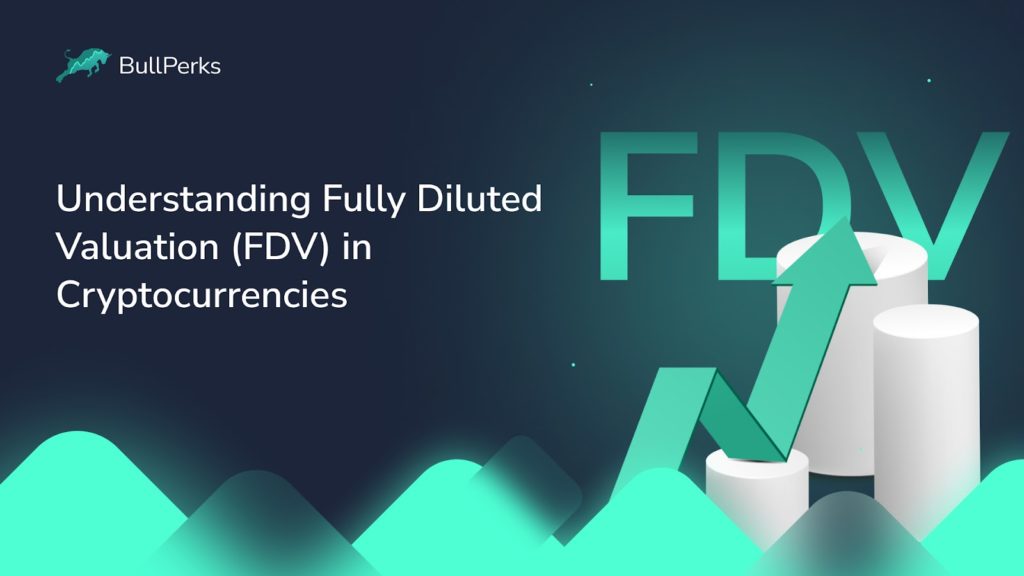
Cryptocurrency is a rapidly growing asset class, with market capitalization reaching trillions of dollars in recent years. As investors and traders alike seek to gain exposure to the crypto markets, understanding key concepts such as Fully Diluted Valuation (FDV) can help them make informed decisions about their investments.
What is FDV in crypto?
Fully diluted valuation (FDV) is the total value of a crypto project, assuming all of its tokens are in circulation. By calculating the fully diluted market cap, investors can assess the true worth of an asset compared to its current market price. This article will explore what FDV means for cryptocurrencies and how it can be used for more accurate valuations. Read on to find out more!
Why Is it Important?
The importance of FDV lies in its ability to provide insight into a cryptocurrency's potential value. In particular, it helps identify if the token is currently undervalued or overvalued. For example, if an asset's FDV is significantly higher than its current market cap, then investors can take advantage of this opportunity by buying up coins at their current price before they appreciate in value.
In addition to helping with valuations, fully diluted valuation can also be used to assess the risk associated with an investment in a particular cryptocurrency project. By understanding the difference between the FDV and market cap for an asset, investors can better gauge the token's potential upside and downside risks; if the market cap is lower than the FDV, then there is more room for growth but also more risk involved. On the other hand, if the two values are close together, then there may be less volatility associated with investing in that token.
Overall, understanding Fully Diluted Valuation (FDV) in cryptocurrencies provides investors with valuable insights into assessing their investments and making informed decisions about which projects have long-term potential for growth and profitability. As such, it should be part of every investor's due diligence process when researching different crypto assets.
How to Calculate Fully Diluted Valuation
Calculating Fully Diluted Valuation (FDV) is an important part of assessing the true value of a cryptocurrency project. While there are several ways to go about this, CoinGecko's Fully Diluted Valuation toggle and their Compare Cryptocurrencies feature are the most popular methods.
FDV Calculator
CoinGecko's Fully Diluted Valuation Toggle
CoinGecko is a website allowing users to compare cryptocurrencies by providing comprehensive market data and analytics. They also offer a tool specifically designed to calculate FDV for coins quickly and easily. All you have to do is search for the cryptocurrency, click on "Fully Diluted Market Cap," and then toggle the switch from "Circulating Supply" to "Total Supply" to get its fully diluted valuation.
CoinGecko's Compare Cryptocurrencies Feature
In addition to their FDV toggle, CoinGecko also has a Compare Cryptocurrencies feature that allows users to assess how different coins stack up against one another in terms of various metrics. This includes their fully diluted valuations as well as other factors such as trading volume and liquidity. This can be an incredibly valuable resource when researching crypto assets, as it gives investors an easy way to evaluate potential investments side-by-side and make more informed decisions about which projects have long-term growth potential.
Manual calculation
For those who prefer a more hands-on approach, calculating FDV can also be done manually.
In brief:
1. Determine the Total Token Supply. You need to know the maximum number of tokens that will ever exist for the given crypto project.
2. Identify theToken Price of the specific round. You should find out the current price of the round.
3. Calculate the FDV. Multiply the total token supply by the current token price of the round. The resulting value is the Fully Diluted Valuation of the cryptocurrency.
FDV = Total Token Supply * Current Token Price
While the manual calculation of FDV is fairly straightforward, it isn't always possible due to certain factors, such as potential future issuances or coin burns, which can lead to changes in both circulating supply and market cap.
Understanding fully diluted valuation (FDV) in cryptocurrencies is essential to assessing their true worth compared to their current market price. By using tools such CoinGecko's Fully Diluted Valuation toggle or Compare Cryptocurrency feature, or alternatively calculating FDVs manually, investors can gain invaluable insights into which projects have higher long-term potentials for growth and profitability.
Let's go through a particular example.To determine our Total Supply, we will compile the sum of the token amounts allocated across all stages and categories. This includes the following:
- Private Rounds A and B
- Key Opinion Leaders (KOLs)
- Public Sale
- Team Allocation
- Development Fund
- Advisory Role
- Marketing Activities
- Rewards Program
- Reserve Fund
- Liquidity Provision
By adding the amounts across these categories, we can accurately calculate the Total Token Supply.
All rounds combined (the Total Supply) = 1.000.000.000
After determining our Total Supply, the next step involves finding the price of tokens for each round.
- Since we have all the information we need, we will calculate the FDV by multiplying the price per token by the Total Supply.
- For the Private A round, with a token price of $0.0050 and a Total Supply of 1,000,000,000, we arrive at a Fully Diluted Valuation (FDV) of $5,000,000.
- In the Private B round, the token price is set at $0.0060. Given the same Total Supply of 1,000,000,000, it leads to an FDV of $6,000,000.
- The KOLs round, the token price increases to $0.0070. With the Total Supply still at 1,000,000,000, the FDV at this stage is $7,000,000.
- For the Public Sale, the token price rises to $0.0080 per token. With the consistent Total Supply of 1,000,000,000, we achieve an FDV of $8,000,000.
This step-by-step calculation reveals the progressive increase in the Fully Diluted Valuation as we advance through each stage of the token offering.
Now let's take a look at the next example.
Let's start our tokenomics analysis by defining the total supply. It is the maximum number of tokens that will ever be issued for this particular crypto project. Ensuring accuracy at this initial stage is necessary for accurate subsequent calculations and estimates.
Upon reviewing the highlighted data provided, we have identified that our Total Supply amounts to 333,000,000 tokens. With this crucial figure established, we can now proceed to the Angel investment round and initiate our computations for the Fully Diluted Valuations.
- For the Angel Investment Round, we multiply the Total Supply of 333,000,000 tokens by the round price of $0.025, resulting in a Fully Diluted Valuation (FDV) of $8,325,000.
- Moving on to the Strategic Investment Round, the Total Supply of 333,000,000 tokens is multiplied by the round price of $0.030. This computation yields an FDV of $9,990,000.
- In the Presale Investment Round, the Total Supply of 333,000,000 tokens is multiplied by the round price of $0.050, leading us to an FDV of $16,650,000.
- During the Key Opinion Leaders (KOLs) Round, the Total Supply of 333,000,000 tokens and the round price of $0.060 generate an FDV of $19,980,000.
- Finally, our calculation for the Public Investment Round remains the same as the previous round. Therefore, multiplying the Total Supply of 333,000,000 tokens by the round price of $0.060 again gives us an FDV of $19,980,000.
FDV vs. Market Cap
| Comparison | FDV (Fully Diluted Valuation) | Market Cap (Market Capitalization) |
|---|---|---|
| Definition | The valuation of a company or cryptocurrency based on the total number of shares or tokens that will be available in the future, including those not yet issued. | The total value of a company's outstanding shares of stock or a cryptocurrency's circulating supply, calculated by multiplying the share price or token price by the current number of shares or tokens in circulation. |
| Timeframe | Considers future potential and includes all possible shares or tokens that might be issued. | Focuses on the present and considers only the shares or tokens that are currently available in the market. |
| Use Cases | Commonly used in the early stages of a company or cryptocurrency when considering potential total dilution or when assessing the potential maximum valuation of an asset. | Commonly used to assess the current value of publicly traded companies or established cryptocurrencies in the market. |
| Sensitivity | More sensitive to changes in the total number of tokens or shares that might be issued in the future. | Sensitive to current market conditions and the immediate demand and supply dynamics of the shares or tokens. |
Fully Diluted Valuation (FDV) and Market Cap are two of the most important metrics used to gauge the value of a cryptocurrency project. While both metrics measure the total value of a particular asset, they are calculated differently and provide different insights into its value.
The market cap is calculated by multiplying the current price of a token by its circulating supply; this provides an estimate of what the token's total capitalization would be if all tokens were sold at that given price. On the other hand, FDV takes into account not only the current circulating supply but also any potential future token issuances, such as those associated with new investments or coin burns. This allows investors to assess better how much potential upside there is for an asset's valuation in the long run.
Additionally, FDV can be used to reflect a project's potential; projects that have greater potential will have higher FDVs than those with less potential due to their ability to account for future token issuance. In comparison, market caps typically overestimate an asset's true value because they do not take into consideration any upcoming token issuances which could significantly alter its total valuation in either direction.
In summary, while both Fully Diluted Valuation (FDV) and Market Cap can be used to evaluate cryptocurrencies, FDV is more useful when it comes to assessing actual value as it takes into account all outstanding tokens as well as any future token issuance that may arise from new investments or other events. By understanding the differences between these two metrics, investors can make more informed decisions about whether or not an asset has long-term growth potential.
Conclusion
In conclusion, fully diluted valuation (FDV) is an important metric when it comes to assessing the true worth of a cryptocurrency project compared to its current market cap. It takes into account not only the circulating supply but also any potential future token issuances, giving investors insight into which projects have higher long-term growth potentials.
With tools such as CoinGecko's Fully Diluted Valuation toggle or the Compare Cryptocurrency feature, manual calculation and understanding the differences between FDV and Market Cap metrics, investors can make more informed decisions about whether or not an asset has long-term growth potential. Ultimately, these insights will help them better understand how they should invest in cryptocurrencies for maximum return on their investments.
Would you like to start investing in the most promising crypto projects? Learn how to invest with BullPerks, the fairest and most community-oriented decentralized VC and multichain launchpad!
Disclaimer.This material should not be construed as a basis for making investment decisions or as a recommendation to participate in investment transactions. Trading digital assets may involve significant risks and can result in the loss of invested capital. Therefore, you must ensure that you fully understand the risk involved, consider your level of experience, investment objectives, and seek independent financial advice if necessary.












